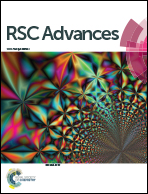Synthesis and evaluation of β-cyclodextrin-functionalized hydrophobically associating polyacrylamide
Abstract
Modified β-cyclodextrin and N-phenethyl-methacrylamide were utilized to react with acrylamide and acrylic acid to synthesize hydrophobically associating polyacrylamide (HMPAM) via photoinitiated free-radical micellar copolymerization. HMPAM was characterized using Fourier transform infrared (FT-IR) spectroscopy, 1H nuclear magnetic resonance (1H NMR), thermogravimetric analysis (TGA), scanning electron microscopy (SEM) and viscometry. Compared with partially hydrolyzed polyacrylamide (HPAM), HMPAM demonstrated superior properties on aspects of thickening ability, salt tolerance, temperature resistance and oil displacement efficiency. It was found that the apparent viscosity reached a maximum at 45 °C and the viscosity retention ratio reached 87.56% at 95 °C; at a certain range of salinity, HMPAM exhibited an evident salt-thickening phenomenon; the simulative enhanced oil recovery tests illustrated that HMPAM could remarkably enhance oil recovery by 16.4% while HPAM could enhance oil recovery by 10.8%. Moreover, the viscoelasticity and surfactant compatibility of HMPAM were investigated. The results indicated that HMPAM has potential application for enhanced oil recovery.


 Please wait while we load your content...
Please wait while we load your content...